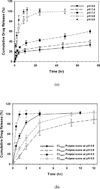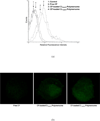Effects of cholesterol incorporation on the physicochemical, colloidal, and biological characteristics of pH-sensitive AB₂ miktoarm polymer-based polymersomes
- PMID: 24463148
- PMCID: PMC3995872
- DOI: 10.1016/j.colsurfb.2013.12.041
Effects of cholesterol incorporation on the physicochemical, colloidal, and biological characteristics of pH-sensitive AB₂ miktoarm polymer-based polymersomes
Abstract
In our previous study, a histidine-based AB2 miktoarm polymer, methoxy poly(ethylene glycol)-b-poly(l-histidine)2 (mPEG-b-(PolyHis)2), was designed to construct pH-sensitive polymersomes that transform in acidic pH; the polymer self-assembles into a structure that mimics phospholipids. In this study, the polymersomes further imitated liposomes due to the incorporation of cholesterol (CL). The hydrodynamic radii of the polymersomes increased with increasing CLwt% (e.g., 70 nm for 0 wt% vs. 91 nm for 1 wt%), resulting in an increased capacity for encapsulating hydrophilic drugs (e.g., 0.92 μL/mg for 0 wt% vs. 1.42 μL/mg for 1 wt%). The CL incorporation enhanced the colloidal stability of the polymersomes in the presence of serum protein and retarded their payload release. However, CL-incorporating polymersomes still demonstrated accelerated release of a hydrophilic dye (e.g., 5(6)-carboxyfluorescein (CF)) below pH 6.8 without losing their desirable pH sensitivity. CF-loaded CL-incorporating polymersomes showed better cellular internalization than the hydrophilic CF, whereas doxorubicin (DOX)-loaded CL-incorporating polymersomes presented similar or somewhat lower anti-tumor effects than free hydrophobic DOX. The findings suggest that CL-incorporating mPEG-b-(PolyHis)2-based polymersomes may have potential for intracellular drug delivery of chemical drugs due to their improved colloidal stability, lower drug loss during circulation, acidic pH-induced drug release, and endosomal disruption.
Keywords: Cholesterol; Colloidal stability; Miktoarm polymer; Poly(histidine); Polymersome; pH-sensitive.
Copyright © 2014 Elsevier B.V. All rights reserved.
Figures







Similar articles
-
Dual-responsive polymersomes as anticancer drug carriers for the co-delivery of doxorubicin and paclitaxel.J Mater Chem B. 2021 Jan 28;9(3):801-808. doi: 10.1039/d0tb02462g. J Mater Chem B. 2021. PMID: 33336680
-
Biocompatible, pH-sensitive AB(2) Miktoarm Polymer-Based Polymersomes: Preparation, Characterization, and Acidic pH-Activated Nanostructural Transformation.J Mater Chem. 2012 Sep 28;22(36):91968-19178. doi: 10.1039/C2JM33750A. J Mater Chem. 2012. PMID: 23002330 Free PMC article.
-
pH-sensitive micelles self-assembled from polymer brush (PAE-g-cholesterol)-b-PEG-b-(PAE-g-cholesterol) for anticancer drug delivery and controlled release.Int J Nanomedicine. 2017 Mar 21;12:2215-2226. doi: 10.2147/IJN.S130037. eCollection 2017. Int J Nanomedicine. 2017. PMID: 28356738 Free PMC article.
-
Advanced liposome and polymersome-based drug delivery systems: Considerations for physicochemical properties, targeting strategies and stimuli-sensitive approaches.Adv Colloid Interface Sci. 2023 Jul;317:102930. doi: 10.1016/j.cis.2023.102930. Epub 2023 May 29. Adv Colloid Interface Sci. 2023. PMID: 37290380 Review.
-
Nanoscale Polymersomes as Anti-Cancer Drug Carriers Applied for Pharmaceutical Delivery.Curr Pharm Des. 2016;22(19):2857-65. doi: 10.2174/1381612822666160217142319. Curr Pharm Des. 2016. PMID: 26898733 Free PMC article. Review.
Cited by
-
pH-induced morphological transition of aggregates formed by miktoarm star polymers in dilute solution: a mesoscopic simulation study.RSC Adv. 2024 Aug 2;14(33):24240-24249. doi: 10.1039/d4ra04511d. eCollection 2024 Jul 26. RSC Adv. 2024. PMID: 39101066 Free PMC article.
-
Miktoarm Star Polymers: Branched Architectures in Drug Delivery.Pharmaceutics. 2020 Aug 30;12(9):827. doi: 10.3390/pharmaceutics12090827. Pharmaceutics. 2020. PMID: 32872618 Free PMC article. Review.
-
Polymersome-based drug-delivery strategies for cancer therapeutics.Ther Deliv. 2015;6(4):521-34. doi: 10.4155/tde.14.125. Ther Deliv. 2015. PMID: 25996048 Free PMC article. Review.
-
Rescue of mitochondrial function in parkin-mutant fibroblasts using drug loaded PMPC-PDPA polymersomes and tubular polymersomes.Neurosci Lett. 2016 Sep 6;630:23-29. doi: 10.1016/j.neulet.2016.06.065. Epub 2016 Jul 10. Neurosci Lett. 2016. PMID: 27412236 Free PMC article.
References
-
- Meng F, Zhong Z, Feijen J. Stimuli-responsive polymersomes for programmed drug delivery. Biomacromolecules. 2009;10:197–209. - PubMed
-
- Yin H, Kang SW, Bae YH. Polymersome formation from AB(2) type 3-miktoarm star copolymers. Macromolecules. 2009;42:7456–7464.
Publication types
MeSH terms
Substances
Grants and funding
LinkOut - more resources
Full Text Sources
Other Literature Sources
Medical

